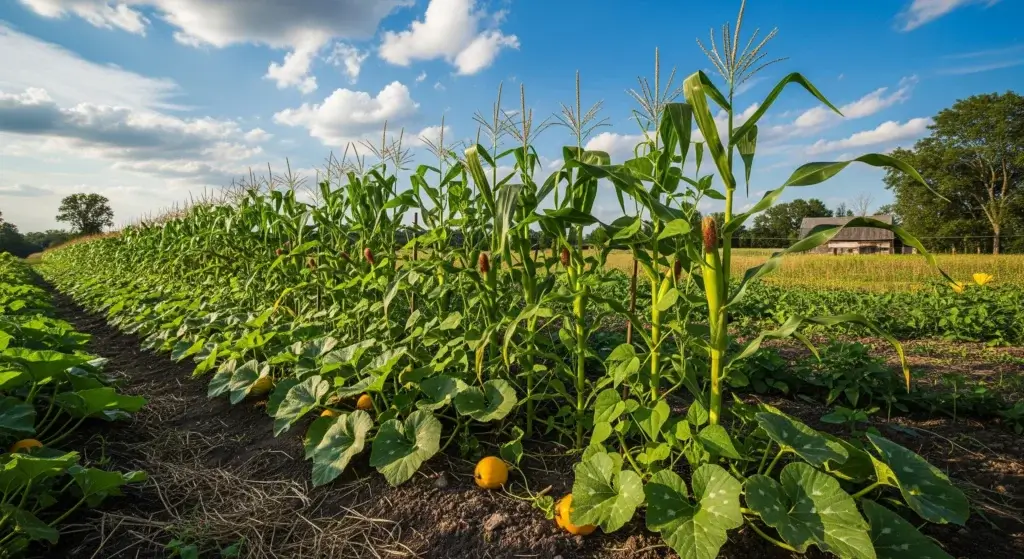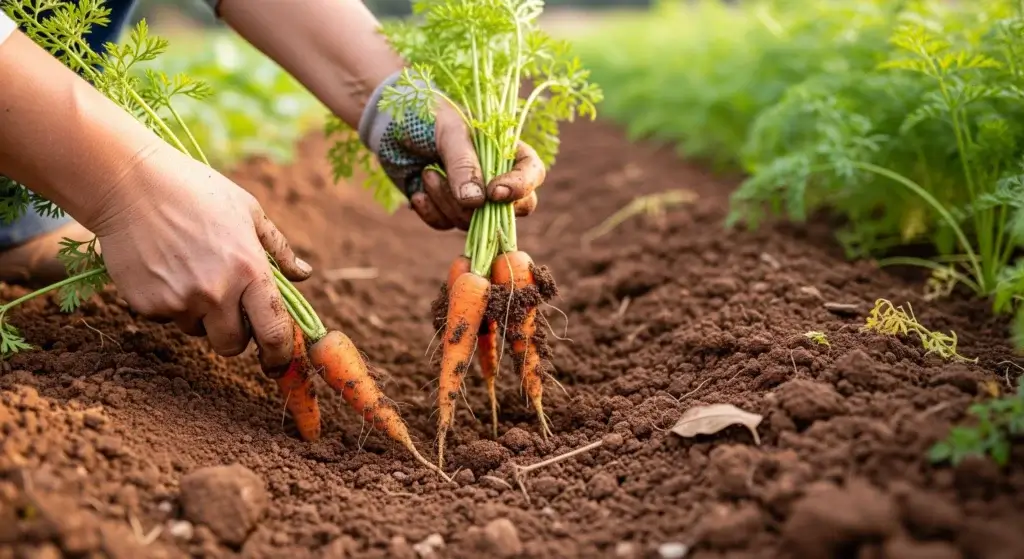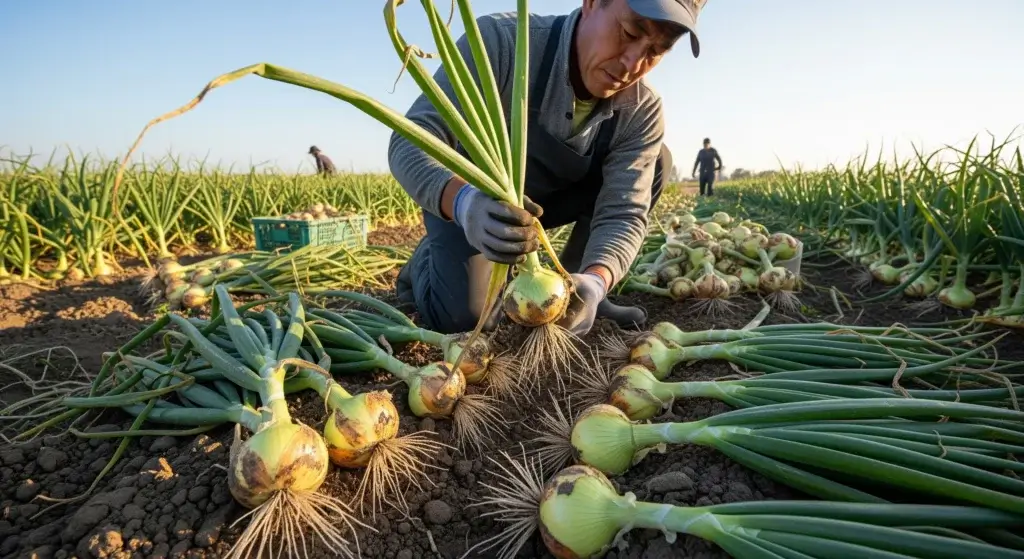
Companion planting is a tried-and-true gardening method where certain plants are grown together to help each other thrive.
When planting pumpkins, choosing the right companion plants can promote healthier growth and lead to a bigger, more successful harvest.
Benefits of Companion Planting for Pumpkins
Companion planting offers several advantages for pumpkin cultivation:
Pest control
Nobody wants their pumpkin plants to be ruined by bugs!
Thankfully, certain plants act as natural repellents.
Marigolds, for example, give off a scent that keeps harmful insects like nematodes away
Stronger and healthier growth
Some plants can actually improve the soil around them, making it more nutritious for pumpkins.
Beans and other legumes help by adding nitrogen to the soil, which is a key nutrient that pumpkins need to grow big and strong.
Enhanced flavor
Gardeners believe that planting certain herbs near pumpkins can enhance their flavor.
For example, marjoram is said to improve the taste of pumpkins growing nearby.
While this might not be scientifically proven, it doesn’t hurt to try—and adding herbs to your garden makes it smell amazing!
Increased yields
Pumpkins rely on bees and other pollinators to turn their flowers into fruit.
Without enough pollination, your pumpkin vines may produce flowers but no pumpkins.
By planting flowers like nasturtiums and borage, you can attract more bees and butterflies to your garden, leading to a bigger harvest.
Weed suppression
Weeds can quickly take over a garden, stealing water and nutrients from your pumpkin plants.
But instead of pulling weeds all the time, you can plant low-growing companions like clover to act as natural ground cover.
Attracting beneficial insects
Having a variety of plants in your garden helps create a natural balance.
Flowers like alyssum attract helpful insects, such as ladybugs and lacewings, that eat pests like aphids.
This reduces the need for pesticides and keeps your pumpkin plants healthier.

Factors to Consider When Choosing Companion Plants
Selecting the right companions involves considering several factors:
Nutrient requirements
Pumpkins are heavy feeders, meaning they soak up a lot of nutrients from the soil, especially nitrogen.
If you plant them next to other nutrient-hungry plants, they’ll end up competing for food, which can stunt their growth.
Pest susceptibility and resistance
Some plants attract pests that can harm pumpkins, while others help keep those pests away.
The goal is to choose plants that protect your pumpkins rather than invite trouble.
For example, marigolds and nasturtiums naturally repel harmful insects, making them great companions.
Soil type compatibility
Pumpkins grow best in rich, well-drained soil with plenty of organic matter.
If a companion plant has very different soil needs (such as those that prefer sandy or dry conditions), it may struggle to thrive alongside pumpkins.
Sunlight and water needs
Pumpkins love full sun and need plenty of water to grow large, healthy fruits.
If you plant something nearby that prefers shade or drier conditions, it might not do well.
Instead, pick plants that thrive in the same environment, ensuring that all your plants get the right amount of sunlight and moisture.

Best Companion Plants for Pumpkins
Here are some top companion plants to consider for your pumpkin patch:
Flowers
Flowers aren’t just for looks—they play a big role in repelling pests and attracting pollinators that help pumpkins grow.
- Marigolds – Keep nematodes and harmful insects away from your pumpkin plants.
- Nasturtiums – Deter squash bugs and aphids while attracting bees and butterflies.
- Borage – Attracts pollinators and may help strengthen pumpkin plants.
- Calendula – Draws in helpful insects that eat common pumpkin pests.
- Alyssum – Lures beneficial insects that prey on aphids and other garden pests.
Herbs
Herbs are great at repelling unwanted bugs and even enhancing flavor in some crops.
- Oregano – Provides natural pest protection and acts as ground cover.
- Thyme – Keeps insects away and may improve the taste of nearby plants.
- Mint – Repels pests but spreads aggressively, so plant it in containers to keep it under control.
Vegetables
Certain vegetables help pumpkins grow bigger and healthier by enriching the soil or providing structure.
- Corn – In the traditional “Three Sisters” planting method, corn gives pumpkin vines some shade and acts as a natural trellis for climbing beans.
- Beans – Also part of the “Three Sisters,” beans add nitrogen to the soil, which helps pumpkins grow strong.
Other
Some plants don’t just help pumpkins—they improve the whole garden by reducing weeds and boosting soil health.
- Clover – Works as a “living mulch” by covering the ground, keeping weeds down, and enriching the soil with nitrogen.
Plants to Avoid Planting Near Pumpkins
While companion planting can offer great benefits, there are some plants that should be kept away from pumpkins to prevent harm to their growth and health.
Potatoes
Potatoes might seem like a good garden companion, but they attract similar pests that also target pumpkins, like beetles.
Additionally, they compete for nutrients in the soil, which can limit the resources your pumpkins need to grow strong and healthy.
Other cucurbits (melons, cucumbers, squash)
Cucurbits, which include melons, cucumbers, and squash, are all in the same plant family as pumpkins.
Planting them together can increase the chances of disease spread (like powdery mildew) and can lead to more pest problems.
They also compete for the same space, water, and nutrients, which can stunt the growth of your pumpkins.
Onions/garlic
Onions and garlic have allelopathic effects, meaning they release substances into the soil that can inhibit the growth of nearby plants, including pumpkins.
While they help repel certain pests, the downside is that they can also hinder your pumpkin plants from reaching their full potential.

How to Implement Companion Planting with Pumpkins
To make companion planting work successfully in your pumpkin patch, here’s a simple guide:
Planting layout
Plan where each companion plant goes to make sure they help each other out.
For example, marigolds work great around the edges of your pumpkin patch because they can help keep pests away.
You want to make sure the plants complement each other, not compete for space.
Timing
Timing is key when planting companions.
Make sure to sow companion plants at the right time in your growing season.
For example, some plants may help in the early stages of growth, while others, like beans, may support the pumpkins later on by adding nitrogen to the soil.
This will ensure your pumpkins get the full benefit throughout their growth.
Maintenance
Keep an eye on how your plants are growing. It’s important to check regularly to ensure that the companion plants aren’t competing too much for water, nutrients, or space.
If any plants are overcrowding your pumpkins, be sure to trim or remove them as needed.
Three sisters method
This traditional Native American planting technique involves growing corn, beans, and pumpkins together.
The corn provides support for the beans, the beans enrich the soil with nitrogen, and the pumpkins’ broad leaves suppress weeds.

Final Thoughts
Companion planting is a great way to boost pumpkin growth and maximize your harvest.
By choosing the right plants to grow alongside your pumpkins, you can improve soil health, deter pests, and create a thriving garden.
With a little planning, your pumpkins will grow stronger and healthier, naturally!



